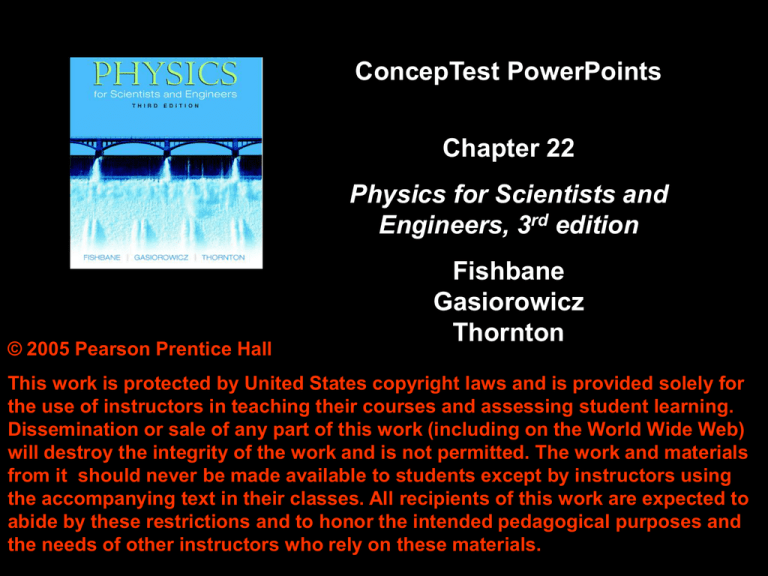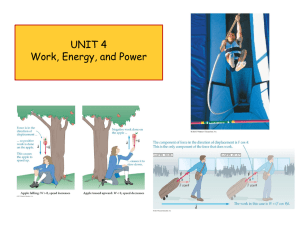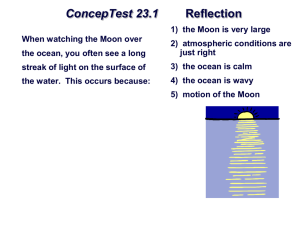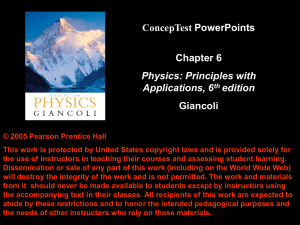
ConcepTest PowerPoints
Chapter 22
Physics for Scientists and
Engineers, 3rd edition
© 2005 Pearson Prentice Hall
Fishbane
Gasiorowicz
Thornton
This work is protected by United States copyright laws and is provided solely for
the use of instructors in teaching their courses and assessing student learning.
Dissemination or sale of any part of this work (including on the World Wide Web)
will destroy the integrity of the work and is not permitted. The work and materials
from it should never be made available to students except by instructors using
the accompanying text in their classes. All recipients of this work are expected to
abide by these restrictions and to honor the intended pedagogical purposes and
the needs of other instructors who rely on these materials.
ConcepTest 22.1 Electric Field
You are sitting a certain distance from
a point charge, and you measure an
electric field of E0. If the charge is
doubled and your distance from the
charge is also doubled, what is the
electric field strength now?
(1) 4 E0
(2) 2 E0
(3) E0
(4) 1/2 E0
(5) 1/4 E0
ConcepTest 22.1 Electric Field
You are sitting a certain distance from
a point charge, and you measure an
electric field of E0. If the charge is
doubled and your distance from the
charge is also doubled, what is the
electric field strength now?
(1) 4 E0
(2) 2 E0
(3) E0
(4) 1/2 E0
(5) 1/4 E0
Remember that the electric field is: E = kQ/r2.
Doubling the charge puts a factor of 2 in the
numerator, but doubling the distance puts a factor
of 4 in the denominator, because it is distance
squared!! Overall, that gives us a factor of 1/2.
Follow-up: If your distance is doubled, what must you do to
the charge to maintain the same E field at your new position?
ConcepTest 22.2a Field and Force I
Between the red and the
blue charge, which of
them experiences the
greater electric field due
to the green charge?
+1
d
+2
1)
+1
2)
+2
3) the same for both
+1
d
+1
ConcepTest 22.2a Field and Force I
Between the red and the
blue charge, which of
them experiences the
greater electric field due
to the green charge?
+1
d
1)
+1
2)
+2
3) the same for both
+2
Both charges feel the same electric
field due to the green charge because
they are at the same point in space!
+1
d
+1
Q
Ek 2
r
ConcepTest 22.2b Field and Force II
Between the red and the
blue charge, which of
them experiences the
greater electric force due
to the green charge?
+1
d
+2
1)
+1
2)
+2
3) the same for both
+1
d
+1
ConcepTest 22.2b Field and Force II
Between the red and the
blue charge, which of
them experiences the
greater electric force due
to the green charge?
+1
d
+2
1)
+1
2)
+2
3) the same for both
+1
The electric field is the same for both charges,
but the force on a given charge also depends
on the magnitude of that specific charge.
d
+1
F qE
ConcepTest 22.3a Superposition I
-2 C
What is the electric field at
2
1
the center of the square?
3
5) E = 0
-2 C
4
ConcepTest 22.3a Superposition I
-2 C
What is the electric field at
2
1
the center of the square?
3
5) E = 0
-2 C
For the upper charge, the E field vector at the center
of the square points towards that charge. For the
lower charge, the same thing is true. Then the vector
sum of these two E field vectors points to the left.
Follow-up: What if the lower charge was +2 C?
What if both charges were +2 C?
4
ConcepTest 22.3b Superposition II
What is the electric field at
-2 C
2
-2 C
1
the center of the square?
3
5) E = 0
-2 C
4
-2 C
ConcepTest 22.3b Superposition II
What is the electric field at
-2 C
2
-2 C
1
the center of the square?
3
5) E = 0
-2 C
The four E field vectors all point outwards
from the center of the square toward their
respective charges. Because they are all
equal, the net E field is zero at the center!!
Follow-up: What if the upper two charges were +2 C?
What if the right-hand charges were +2 C?
4
-2 C
ConcepTest 22.3c Superposition III
-Q
+Q
What is the direction of
the electric field at the
position of the X ?
2
3
1
4
+Q
5
ConcepTest 22.3c Superposition III
-Q
+Q
What is the direction of
the electric field at the
position of the X ?
2
3
1
4
+Q
5
The two +Q charges give a resultant E field
that is down and to the right. The –Q charge
has an E field up and to the left, but smaller
in magnitude. Therefore, the total electric
field is down and to the right.
Follow-up: What if all three charges reversed their signs?
ConcepTest 22.4 Find the Charges
Two charges are fixed along
the x-axis. They produce an
electric field E directed along
the negative y-axis at the
indicated point. Which of
the following is true?
1) charges are equal and positive
2) charges are equal and negative
3) charges are equal and opposite
4) charges are equal, but sign is
undetermined
5) charges cannot be equal
y
E
Q1
Q2
x
ConcepTest 22.4 Find the Charges
Two charges are fixed along
the x-axis. They produce an
electric field E directed along
the negative y-axis at the
indicated point. Which of
the following is true?
1) charges are equal and positive
2) charges are equal and negative
3) charges are equal and opposite
4) charges are equal, but sign is
undetermined
5) charges cannot be equal
y
The way to get the resultant PINK vector
is to use the GREEN and BLUE vectors.
These E vectors correspond to equal
E
charges (because the lengths are equal)
that are both negative (because their
directions are toward the charges).
Q1
Q2
Follow-up: How would you get the E field to point toward the right?
x
ConcepTest 22.5 Uniform Electric Field
In a uniform electric field in empty
space, a 4 C charge is placed and it
feels an electrical force of 12 N. If
this charge is removed and a 6 C
charge is placed at that point
instead, what force will it feel?
Q
1) 12 N
2) 8 N
3) 24 N
4) no force
5) 18 N
ConcepTest 22.5 Uniform Electric Field
In a uniform electric field in empty
space, a 4 C charge is placed and it
feels an electrical force of 12 N. If
this charge is removed and a 6 C
charge is placed at that point
instead, what force will it feel?
1) 12 N
2) 8 N
3) 24 N
4) no force
5) 18 N
Since the 4 C charge feels a force, there must
be an electric field present, with magnitude:
E = F / q = 12 N / 4 C = 3 N/C
Once the 4 C charge is replaced with a 6 C
Q
charge, this new charge will feel a force of:
F = q E = (6 C)(3 N/C) = 18 N
Follow-up: What if the charge is placed at a different position in the field?
ConcepTest 22.6a Electric Field Lines I
1)
What are the signs of the
charges whose electric
fields are shown at right?
2)
3)
4)
5) no way to tell
ConcepTest 22.6a Electric Field Lines I
1)
What are the signs of the
charges whose electric
fields are shown at right?
2)
3)
4)
5) no way to tell
Electric field lines originate on
positive charges and terminate
on negative charges.
ConcepTest 22.6b Electric Field Lines II
Which of the charges has
the greater magnitude?
1)
2)
3) Both the same
ConcepTest 22.6b Electric Field Lines II
Which of the charges has
the greater magnitude?
1)
2)
3) Both the same
The field lines are denser around
the red charge, so the red one
has the greater magnitude.
Follow-up: What is the red/green ratio
of magnitudes for the two charges?









